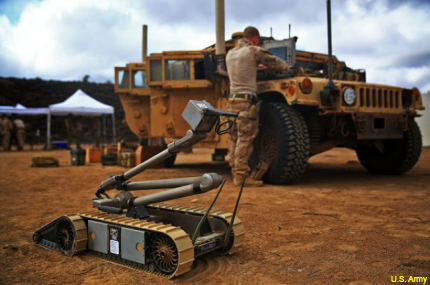Army maps out plan for better, smarter ground robots
A new program also wants to establish standard platforms and modular designs to allow for fast development and easy upgrades.

A PackBot is ready for duty, in this case in Djibouti.
The fact that the Army envisions a future in which ground robots work more closely with soldiers isn’t much of a surprise—the military has been making greater use of robotic systems for years. But the service is planning to change the way it acquires those robots, by requiring modular, open-architecture systems on standardized platforms that can be developed and upgraded more quickly.
For over 10 years in Iraq and Afghanistan, the military made use of ground robots for a variety of missions, from mine-clearing and transportation to sniffing out improvised explosives and conducting surveillance. But those devices were acquired on an as-needed and/or as-available basis, leaving the Army today with a ragtag assortment of non-standardized pieces that don’t work together and don’t lend themselves to easy upgrades.
The new Robotic Enhancement Program, announced last week at the National Defense Industrial Association’s Ground Robotics Capabilities Conference and Exhibition, is out to change that. Along with working with industry to develop smaller, lighter, smarter robots, the Army wants to do it more quickly and cost-effectively.
All those disparate robotic systems, valuable as they may have been for saving soldiers’ lives, have created a “sustainment burden” for the Army, Scott Davis, program executive officer for Combat Support and Combat Service Support, said at the conference. The devices were acquired through contingency operating funds, rather than as a budgeted program of record, which leaves the Army without the established path for continuing a program.
So that’s one change underway—the Army is planning to field robotics programs of record between 2019 and 2024, Davis said. The other change will be in how those robotic systems will be developed, tested and fielded.
The idea behind REP is similar to that of the Soldier Enhancement Program, which works to get new technologies to soldiers and Marines at the “speed of industry.” Robotics technology is improving rapidly, often proceeding from effectiveness to obsolescence faster than the military’s standard three- to seven-year procurement process allows, Davis said. REP can speed that up by standardizing on specific platforms, testing products in small quantities and then accelerating the validation and funding processes.
The Army wants modular autonomous and semiautonomous systems that allow for incremental hardware, software, sensor and payload upgrades, and have an open architecture in their in- and out-processing software. It’s also looking for improvements over current systems in miniaturization, weight and intelligent behavior—the last factor with regard to a robot being smart enough to be easy for a soldier to use.
The service currently is evaluating many of the last decade’s worth of non-standard systems to see which could qualify for program-of-record status. One that is on the path, Davis said, is the Man-Transportable Robotics System Mark II, used for explosives ordnance disposal, which will use an existing platform, controller and base software.
Other systems being evaluated include the Husky Mounted Detection System, the Route Clearance and Interrogation System and the Common Robotic System Individual, along with robotics such as the Talon IV, Packbot 510 FASTAC, Dragon Runner and First Look.




